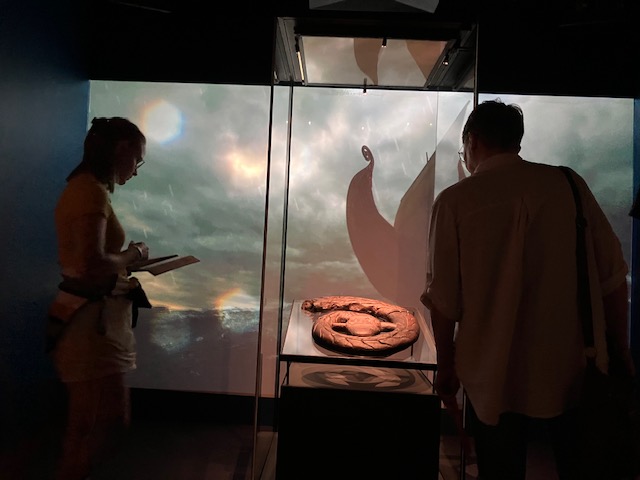While Norwegians and tourists alike wait for Norway’s new Viking ships museum to open in 2027, an alternative exhibition opened this summer. Even though the famed Oseberg ship remains under wraps, part of its original decor is on display for the first time ever.
Signs featuring the Oseberg Viking ship’s original serpent’s head have pointed the way to it, like here in front of the University of Oslo’s ceremonial hall. PHOTO: NewsinEnglish.no/Nina Berglund
Not many are aware of it, but the famed serpent’s head on the bow of the most majestic of Norway’s Viking ships is actually a copy. The original is so fragile, and also was in the early 1900s when the Oseberg ship was found, that it wasn’t remounted on the ship when the rest of it went on public display in 1926.
The serpent’s head, found separately from the ship, has instead been stored away at the University of Oslo’s Historic Museum downtown for the past 99 years. It’s ironic, since the Viking ship from which it came was unusually intact when it was discovered and excavated in 1904. Only the tallest parts of the ship were damaged, and the wood used for the coiling serpent and its head was too brittle to re-attach.
Instead, two copies were made and mounted at each end of the Viking ship Oseberg that otherwise consists of 90 percent of its original woodwork. “It’s an iconic symbol that has been used in countless ways in Norway, even on our 20-kroner coin,” Hanne Lovise Aannestad, an archaeologist who’s also in charge of storage rooms at the museum, told newspaper Aftenposten before the exhibit opened in June.
Here’s the original ornamentation of the Oseberg Viking ship, on display at the historic museum. PHOTO: NewsinEnglish.no/Nina Berglund
The original, though, was tucked away in the Historic Museum’s vaults. Aannestad said it was brought out in the 1950s and restoration work was done on it, but then it was packed up and stored away again. She thinks that’s because of a lack of space at the old Viking ships museum on Oslo’s Bygdøy peninsula, which closed in 2021 and is due to reopen in a much-expanded version in 2027. The process of moving its three Viking ships into the new portion of the museum began this week.
“There’s a lot we’ve never been able to put on display,” Aanestad said. “We have an entire room full of boxes containing items that have never been on public display.”
There will be much more exhibit space at the new museum, which is being called the “Museum of the Viking Age” since it will display much more than Norway’s three Viking ships. The serpent’s head will be among the “new” items on offer, and in the meantime, the Historic Museum has been showing it off through its own exhibition roughly translated as Midtgardr, the Vikings’ Mystical World. It also contains scores of other objects and information from the Viking Age.
It was packed on a recent Sunday, even when the sun was shining outside. Lots of silver and gold items were plundered from the graves of high-ranking Vikings who were buried with their ships, but many other items survived a raid believed to have taken place at the Oseberg burial mound in 970AD. Museum officials believe grave robbers literally sawed ornamentation off ships, including the serpent’s head on the Oseberg ship, but then left it in the mud that ironically preserved it until it was found by a farmer in 1903 who alerted authorities.
NewsinEnglish.no/Nina Berglund





